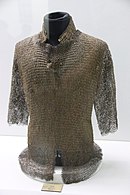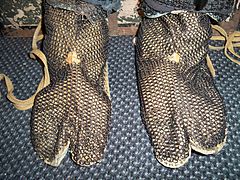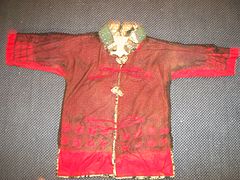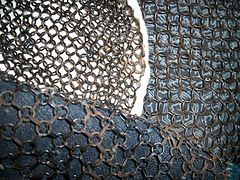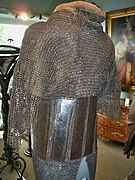Chain mail

Chain mail (also known as chain-mail, mail or maille)[1] is a type of armour consisting of small metal rings linked together in a pattern to form a mesh. It was in common military use between the 3rd century BC and the 16th century AD in Europe, while it continued to be used in Asia, Africa, and the Middle East as late as the 17th century. A coat of this armour is often called a hauberk or sometimes a byrnie.
History
The earliest examples of surviving mail were found in the
Herodotus wrote that the ancient Persians wore scale armour, but mail is also distinctly mentioned in the Avesta, the ancient holy scripture of the Persian religion of Zoroastrianism that was founded by the prophet Zoroaster in the 5th century BC.[12]
Mail continues to be used in the 21st century as a component of stab-resistant
Etymology
The origins of the word mail are not fully known. One theory is that it originally derives from the Latin word macula, meaning 'spot' or 'opacity' (as in
The first attestations of the word mail are in Old French and Anglo-Norman: maille, maile, or male or other variants, which became mailye, maille, maile, male, or meile in Middle English.[15]

Civilizations that used mail invented specific terms for each garment made from it. The standard terms for European mail armour derive from French: leggings are called
A waist-length coat in medieval Europe was called a byrnie, although the exact construction of a byrnie is unclear, including whether it was constructed of mail or other armour types. Noting that the byrnie was the "most highly valued piece of armour" to the Carolingian soldier, Bennet, Bradbury, DeVries, Dickie, and Jestice[16] indicate that:
There is some dispute among historians as to what exactly constituted the Carolingian byrnie. Relying... only on artistic and some literary sources because of the lack of archaeological examples, some believe that it was a heavy leather jacket with metal scales sewn onto it with strong thred. It was also quite long, reaching below the hips and covering most of the arms. Other historians claim instead that the Carolingian byrnie was nothing more than a coat of mail, but longer and perhaps heavier than traditional early medieval mail. Without more certain evidence, this dispute will continue.
In Europe

The use of mail as battlefield armour was common during the Iron Age and the Middle Ages, becoming less common over the course of the 16th and 17th centuries when plate armour and more advanced firearms were developed. It is believed that the Roman Republic first came into contact with mail fighting the Gauls in Cisalpine Gaul, now Northern Italy.[17] The Roman army adopted the technology for their troops in the form of the lorica hamata which was used as a primary form of armour through the Imperial period.
After the fall of the Western Empire, much of the infrastructure needed to create plate armour diminished. Eventually the word "mail" came to be synonymous with armour.[18][19][20][21] It was typically an extremely prized commodity, as it was expensive and time-consuming to produce and could mean the difference between life and death in a battle. Mail from dead combatants was frequently looted and was used by the new owner or sold for a lucrative price. As time went on and infrastructure improved, it came to be used by more soldiers. The oldest intact mail hauberk still in existence is thought to have been worn by Leopold III, Duke of Austria, who died in 1386 during the Battle of Sempach.[22]
By the 14th century, articulated
During the late 19th and early 20th century, mail was used as a material for
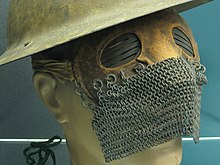
Mail was also used for face protection in World War I.
In Asia
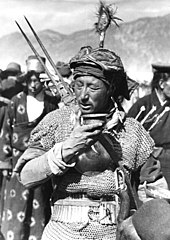
Mail armour was introduced to the Middle East and Asia through the Romans and was adopted by the
Mail armour is mentioned in the Quran as being a gift revealed by Allah to David:
21:80 It was We Who taught him the making of coats of mail for your benefit, to guard you from each other's violence: will ye then be grateful? (Yusuf Ali's translation)
From the
China
Mail was introduced to
Japan
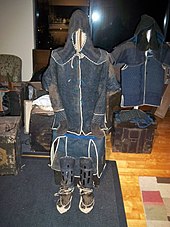
In Japan, mail is called kusari which means chain. When the word kusari is used in conjunction with an armoured item it usually means that mail makes up the majority of the armour composition.[36] An example of this would be kusari gusoku which means chain armour. Kusari jackets, hoods, gloves, vests, shin guards, shoulder guards, thigh guards, and other armoured clothing were produced, even kusari tabi socks.
The rings of Japanese mail were much smaller than their European counterparts; they would be used in patches to link together plates and to drape over vulnerable areas such as the armpits.
Riveted kusari was known and used in Japan. On page 58 of the book Japanese Arms & Armor: Introduction by H. Russell Robinson, there is a picture of Japanese riveted kusari,[39] and this quote from the translated reference of Sakakibara Kozan's 1800 book, The Manufacture of Armour and Helmets in Sixteenth-Century Japan, shows that the Japanese not only knew of and used riveted kusari but that they manufactured it as well.
... karakuri-namban (riveted namban), with stout links each closed by a rivet. Its invention is credited to Fukushima Dembei Kunitaka, pupil, of Hojo Awa no Kami Ujifusa, but it is also said to be derived directly from foreign models. It is heavy because the links are tinned (biakuro-nagashi) and these are also sharp-edged because they are punched out of iron plate[40]
Butted or split (twisted) links made up the majority of kusari links used by the Japanese. Links were either butted together meaning that the ends touched each other and were not riveted, or the kusari was constructed with links where the wire was turned or twisted[41] two or more times; these split links are similar to the modern split ring commonly used on keychains. The rings were lacquered black to prevent rusting, and were always stitched onto a backing of cloth or leather. The kusari was sometimes concealed entirely between layers of cloth.[42]
Kusari gusoku or chain armour was commonly used during the Edo period 1603 to 1868 as a stand-alone defense. According to George Cameron Stone
Entire suits of mail kusari gusoku were worn on occasions, sometimes under the ordinary clothing[43]
In his book Arms and Armor of the Samurai: The History of Weaponry in Ancient Japan,[44] Ian Bottomley shows a picture of a kusari armour and mentions kusari katabira (chain jackets) with detachable arms being worn by samurai police officials during the Edo period. The end of the samurai era in the 1860s, along with the 1876 ban on wearing swords in public, marked the end of any practical use for mail and other armour in Japan. Japan turned to a conscription army and uniforms replaced armour.[45]
Effectiveness

Mail's resistance to weapons is determined by four factors: linkage type (
When the mail was not riveted, a thrust from most sharp weapons could penetrate it. However, when mail was riveted, only a strong well-placed thrust from certain spears, or thin or dedicated mail-piercing swords like the
The flexibility of mail meant that a blow would often injure the wearer,[49] potentially causing serious bruising or fractures, and it was a poor defence against head trauma. Mail-clad warriors typically wore separate rigid helms over their mail coifs for head protection. Likewise, blunt weapons such as maces and warhammers could harm the wearer by their impact without penetrating the armour; usually a soft armour, such as gambeson, was worn under the hauberk. Medieval surgeons were very well capable of setting and caring for bone fractures resulting from blunt weapons.[50] With the poor understanding of hygiene, however, cuts that could get infected were much more of a problem.[50] Thus mail armour proved to be sufficient protection in most situations.[51][52]
Manufacture

Several patterns of linking the rings together have been known since ancient times, with the most common being the 4-to-1 pattern (where each ring is linked with four others). In Europe, the 4-to-1 pattern was completely dominant. Mail was also common in East Asia, primarily Japan, with several more patterns being utilised and an entire nomenclature developing around them.
Historically, in Europe, from the pre-Roman period on, the rings composing a piece of mail would be riveted closed to reduce the chance of the rings splitting open when subjected to a thrusting attack or a hit by an arrow.
Up until the 14th century European mail was made of alternating rows of round riveted rings and solid rings. Sometime during the 14th century European mail makers started to transition from round rivets to wedge shaped rivets but continued using alternating rows of solid rings. [
Modern uses
Practical uses

Mail is used as protective clothing for butchers against meat-packing equipment. Workers may wear up to 4 kg (8.8 lb) of mail under their white coats.[55] Butchers also commonly wear a single mail glove to protect themselves from self-inflicted injury while cutting meat, as do many oyster shuckers.[56]
Scuba divers sometimes use mail to protect them from sharkbite, as do animal control officers for protection against the animals they handle. In 1980, marine biologist Jeremiah Sullivan patented his design for Neptunic full coverage chain mail shark resistant suits which he had developed for close encounters with
Mail is widely used in industrial settings as shrapnel guards and splash guards in metal working operations.[citation needed]
Electrical applications for mail include RF leakage testing and being worn as a Faraday cage suit by tesla coil enthusiasts and high voltage electrical workers.[59][60]
Stab-proof vests
Conventional textile-based ballistic vests are designed to stop soft-nosed bullets but offer little defense from knife attacks. Knife-resistant armour is designed to defend against knife attacks; some of these use layers of metal plates, mail and metallic wires.[61]
Historical re-enactment

Many historical reenactment groups, especially those whose focus is Antiquity or the Middle Ages, commonly use mail both as practical armour and for costuming. Mail is especially popular amongst those groups which use steel weapons. A modern hauberk made from 1.5 mm diameter wire with 10 mm inner diameter rings weighs roughly 10 kg (22 lb) and contains 15,000–45,000 rings.[citation needed]
One of the drawbacks of mail is the uneven weight distribution; the stress falls mainly on shoulders. Weight can be better distributed by wearing a belt over the mail, which provides another point of support.[62]
Mail worn today for re-enactment and recreational use can be made in a variety of styles and materials. Most recreational mail today is made of butted links which are galvanised or stainless steel. This is historically inaccurate but is much less expensive to procure and especially to maintain than historically accurate reproductions. Mail can also be made of titanium, aluminium, bronze, or copper. Riveted mail offers significantly better protection ability as well as historical accuracy than mail constructed with butted links. Japanese mail (kusari) is one of the few historically correct examples of mail being constructed with such butted links.[41]
Decorative uses


Mail remained in use as a decorative and possibly high-status symbol with military overtones long after its practical usefulness had passed. It was frequently used for the epaulettes of military uniforms. It is still used in this form by some regiments of the British Army.
Mail has applications in sculpture and jewellery, especially when made out of precious metals or colourful anodized metals. Mail artwork includes headdresses, decorative wall hangings, ornaments, chess sets, macramé, and jewelry. For these non-traditional applications, hundreds of patterns (commonly referred to as "weaves") have been invented.[63]
Large-linked mail is occasionally used as a fetish clothing material, with the large links intended to be highly inappropriate
In film
In some films, knitted string spray-painted with a metallic paint is used instead of actual mail in order to cut down on cost (an example being
Gallery
-
Edo period 1800s Japanese (samurai) mail socks or kusari tabi, butted rings.
-
Japanese Edo period mail jacket, butted rings kusari katabira.
-
Edo period Japanese (samurai) mail gauntlets kusari han kote, butted rings.
-
A rare example of Japanese riveted mail, round riveted rings.
-
Examples of Edo period Japanese (samurai) mail kusari.
-
Riveted mail and plate coat zirah bagtar. Armour of this type was introduced into India under the Mughals.
-
Close up of Mughal riveted mail and plate coat zirah Bagtar, 17th century, alternating rows of solid rings and round riveted rings.
-
Close up detail of Mughal riveted mail hood kulah zirah, 17th century, alternating rows of round riveted rings and solid rings.
-
Mughal riveted mail and plate coat zirah Bagtar, 17th century, alternating rows of round riveted rings and solid rings.
-
Mughal riveted mail hood kulah zirah. 17th century, alternating rows of round riveted rings and solid rings.
-
"David rejects the unaccustomed armour" (detail of fol. 28r of the 13th century Morgan Bible). The image depicts a method of removing a hauberk.
-
Indian theta link mail (bar link mail), alternating rows of solid theta rings and round riveted rings, 17th century.
-
Ottoman riveted mail, alternating rows of round riveted links and solid links, 16th century.
-
European wedge riveted mail, showing both sides of the rings, 16th to 17th century.
-
Man wearing mail in modern days.
See also
Mail-based armour
- Banded mail
- Hauberk
- Mail and plate armour
- Kusari (Japanese mail armour)
- Lorica hamata
- Lorica plumata with scales attached to a backing of mail
- Tatami (Japanese armour)
- Baju Rantai, type of mail from the Nusantara archipelago
Armour supplementary to mail
Typically worn under mail armour if thin or over mail armour if thick:
- Gambeson (also known as quilted armour or a padded jack)
Can be worn over mail armour:
- Brigandine
- Coat of plates
- Lamellar armour
- Mirror armour (supplementary plates worn over mail)
- Scale armour
- Splint armour
- Transitional armour
Others:
References
- ^ "chain mail" Cambridge dictionaries online Archived 2015-11-24 at the Wayback Machine
- ^ Ashton, Kasey. "The Celts Themselves." University of North Carolina. Accessed 4 November 2018.
- ^ Gonagle, Brendan Mac. "Celtic Chainmail | Brendan Mac Gonagle - Academia.edu". Balkancelts.
- ^ "Celtic chainmail – Balkan Celts". 8 July 2013.
- ^ Rusu, M., "Das Keltische Fürstengrab von Ciumeşti in Rumänien", Germania 50, 1969, pp. 267–269
- ^ The ancient world, Richard A. Gabriel, Greenwood Publishing Group, 2007 P.79 Archived 2016-05-01 at the Wayback Machine
- ^ Oriental Armour, H. Russell Robinson, 1967 Walker and Co., New York, pp. 11-12
- ^ Catalogue of the Exhibition of Ancient Helmets and Examples of Mail, William Burgess & Baron De Cosson
- A Glossary of the Construction, Decoration and Use of Arms And Armor in All Countries and in All Times, Dover Publications, New York
- ISBN 1-85285-374-3, p.159
- ISBN 0-313-31342-3, p.309
- ^ Laufer, Berthold (1914-01-01). Notes on Turquois in the East. Archived from the original on 2017-12-23.
- ^ "mail". Oxford English Dictionary (Online ed.). Oxford University Press. (Subscription or participating institution membership required.)
- ^ "maille", Trésor de la langue française informatisé. Archived 2016-03-05 at the Wayback Machine
- ^ "maille", The Middle English Dictionary Online. Archived 2013-07-31 at the Wayback Machine
- ^ Bennet, M., Bradbury, J., DeVries, K., Dickie, I., & Jestice, P. Fighting Techniques of the Medieval World. Thomas Dunne Books, 2005, p. 82.
- ^ "Chainmail". Archived from the original on 2013-01-15. Retrieved 2013-02-13.
- ^ Francis Grose, A Treatise on Ancient Armour and Weapons, London, 1786
- ^ Samuel R. Meyrick, A Critical Inquiry into Ancient Armour, as it Existed in Europe, but Particularly in England, from the Norman Conquest to the Reign of King Charles II: with a Glossary of Military Terms of the Middle Ages, (London, 1824
- ^ Charles Henry Ashdown, British and Foreign Arms and Armour, (London, 1909
- ^ Eugène Emmanuel Viollet-le-duc, Encyclopédie Médiévale and Dictionnaire Raisonne du Mobilier Francais de l'Epoque Carlovingienne a la Renaissance.
- ^ Strayer, Joseph R. (1982). Dictionary of the Middle Ages. Charles Scribner's Sons.
- ^ Reed Jr., Robert W. "Armour Purchases and Lists from the Howard Household Books", The Journal of the Mail Research Society, Vol. 1. No. 1, July 2003
- ^ Breiding, Dirk H. "Fashion in European Armor, 1600–1700". Department of Arms and Armor, The Metropolitan Museum of Art. Retrieved 2020-10-03.
- ^ "Men Who Wear Armour". The Daily Mail. 1886.
- ^ Randolph, T.H. (1892). The Wilkinson Sword Catalog. The Wilkinson Sword Co. Ltd. p. 41.
- ^ Google Books Archived 2016-05-03 at the Wayback Machine Iron Men
- ^ Robinson, H. Russel (2002). Oriental Armour. Courier Dover Publications. p. 85.
- ^ Stone, George Cameron (1999). A Glossary of the Construction, Decoration and Use of Arms and Armor: In All Countries and in All Times. Courier Dover Publications. p. 69.
- ^ "Ethnographic Arms & Armour - View Single Post - African knights - African armour collection thread". www.vikingsword.com. Retrieved 2024-02-23.
- ^ Dean, Bashford (1920). Helmets and body armor in modern warfare. New Haven: Yale University Press. p. 133. Retrieved 2023-10-12 – via Library of Congress.
- hdl:1959.4/55193.
- ^ "Tank Splatter Mask". American Militaria Reference. Retrieved 2023-10-12.
- ^ David G Alexander, Decorated and inscribed mail shirts in the Metropolitan Museum, Waffen- und Kostumkunde 27 (1985), 29–36
- ^ "8". 曹子建集.
先帝赐臣铠:黑光、明光各一领、两当铠一领、环锁铠一领、马铠一领。今代以昇平,兵革无事,乞悉以付铠曹自理。
- ^ A Glossary of the Construction, Decoration and Use of Arms and Armor: In All Countries and in All Times, George Cameron Stone, Courier Dover Publications, 1999 p. 403 Archived 2016-05-27 at the Wayback Machine
- ^ Brassey's Book of Body Armor, Robert C. Woosnam-Savage, Anthony Hall, Brassey's, 2002 p.92 Archived 2016-05-04 at the Wayback Machine
- ISBN 1-86222-002-6
- ISBN 9780853680192.
- ^ The manufacture of armour and helmets in sixteenth century Japan: (Chūkokatchū seisakuben) Kōzan Sakakibara, C. E. Tuttle, 1964 p.84 Archived 2016-05-12 at the Wayback Machine
- ^ ISBN 978-0-486-40726-5. Archivedfrom the original on 3 June 2016. Retrieved 18 February 2011.
- ^ The manufacture of armour and helmets in sixteenth century Japan: (Chūkokatchū seisakuben) Kōzan Sakakibara, C. E. Tuttle, 1964 p.85 Archived 2016-05-12 at the Wayback Machine
- ISBN 978-0-486-40726-5. Archivedfrom the original on 1 May 2016. Retrieved 18 February 2011.
- ISBN 1-86222-002-6
- ^ The connoisseur's book of Japanese swords, Kōkan Nagayama, Kodansha International Archived 2016-04-27 at the Wayback Machine, 1998 p. 43
- ^ Archived at Ghostarchive and the Wayback Machine: "Old vs. New - Bows and Crossbows tested on Butted and Riveted Mail Armor ("Chainmail")". YouTube.
- ^ "Arms & Armor 12th Century Spear VS. Riveted Mail and Ballistic Gel". YouTube. Archived from the original on 2017-12-23.
- ^ Thordeman, Bengt (1940). Armour from the Battle of Wisby 1361. Stockholm, Sweden: Kungl. Vitterhets Historie och Antikvitets Akademien. p. 160.
- ^ D. Edge and J. Paddock. Arms and Armour of the Medieval Knight (London: Bison), 1988
- ^ a b Mitchell, Piers D. Medicine in the Crusades: Warfare, Wounds and the Medieval Surgeon. Cambridge University Press, 2007.
- ^ Williams, The Knight and the Blast Furnace. pp. 942–943
- ^ Horsfall, I. et al., "An Assessment of Human Performance in Stabbing", Forensic Science International, 102 (1999). pp. 79–89.
- S2CID 162329279.
- ^ Dominic Tweddle, The Anglian Helmet from Coppergate, Archaeology of York 17/8, York Archaeological Trust 1992
- ^ Schlosser, Eric (September 3, 1998). "Fast-Food Nation: Meat and Potatoes". Rolling Stone. No. 794. Retrieved 2020-11-19.
- ^ "Oyster Shucking Gloves: The Pros Wear them [and you should too]". 26 December 2017.
- ^ "Chainmail, Metal Spikes and Unbreakable Material: Can We Design a 'Shark-Proof' Wetsuit?".
- ^ "Stainless steel chainmail diving suit worn by Valerie Taylor". collections.anmm.gov.au. Retrieved 2020-10-29.
- ^ Douglas, David (director) (2002). Straight Up: Helicopters in Action. Smithsonian Institution's National Air and Space Museum.
- ^ Blake, Terry. "Dr Zeus - Testing of HV Suit w Twin Musical Tesla Coils". Daily Planet Segment 2008. Discovery Channel. Archived from the original on 2011-08-29. Retrieved 2011-08-20.
- ^ Illustrated Directory of Special Forces, Ray Bonds, David Miller, Zenith Imprint, 2003 p. 368 Archived 2016-05-06 at the Wayback Machine
- ^ magpie (29 August 2015). "Wearing Chainmail". Birds Before the Storm. Retrieved 2020-09-29.
- ^ DeviantArt.com. Archived 2009-06-19 at the Wayback Machine
External links
- Erik D. Schmid/The Mail Research Society
- The Treatment of Mail on an Arm Guard from the Armoury of the Shah Shuja: Ethical Repair and in situ Documentation in Miniature
- Excavated lorica hamata
- Maillers Worldwide - weaves/tutorials/articles, and gallery photos
- The Maille Artisans International League (MAIL) – Hundreds of weaves/tutorials/articles, and gallery pictures
- "Mail: Unchained", an article taking an in-depth look at the construction and usage of European chain mail
- Construction tips
- Ancient Roman originals can be seen on the pages of the Roman Military Equipment Web museum, Romancoins.info
- http://artofchainmail.com/patterns/european/index.html
- http://www.iranicaonline.org/articles/armor-ii
- Chain Mail 101: Learn all about making Chain Mail

